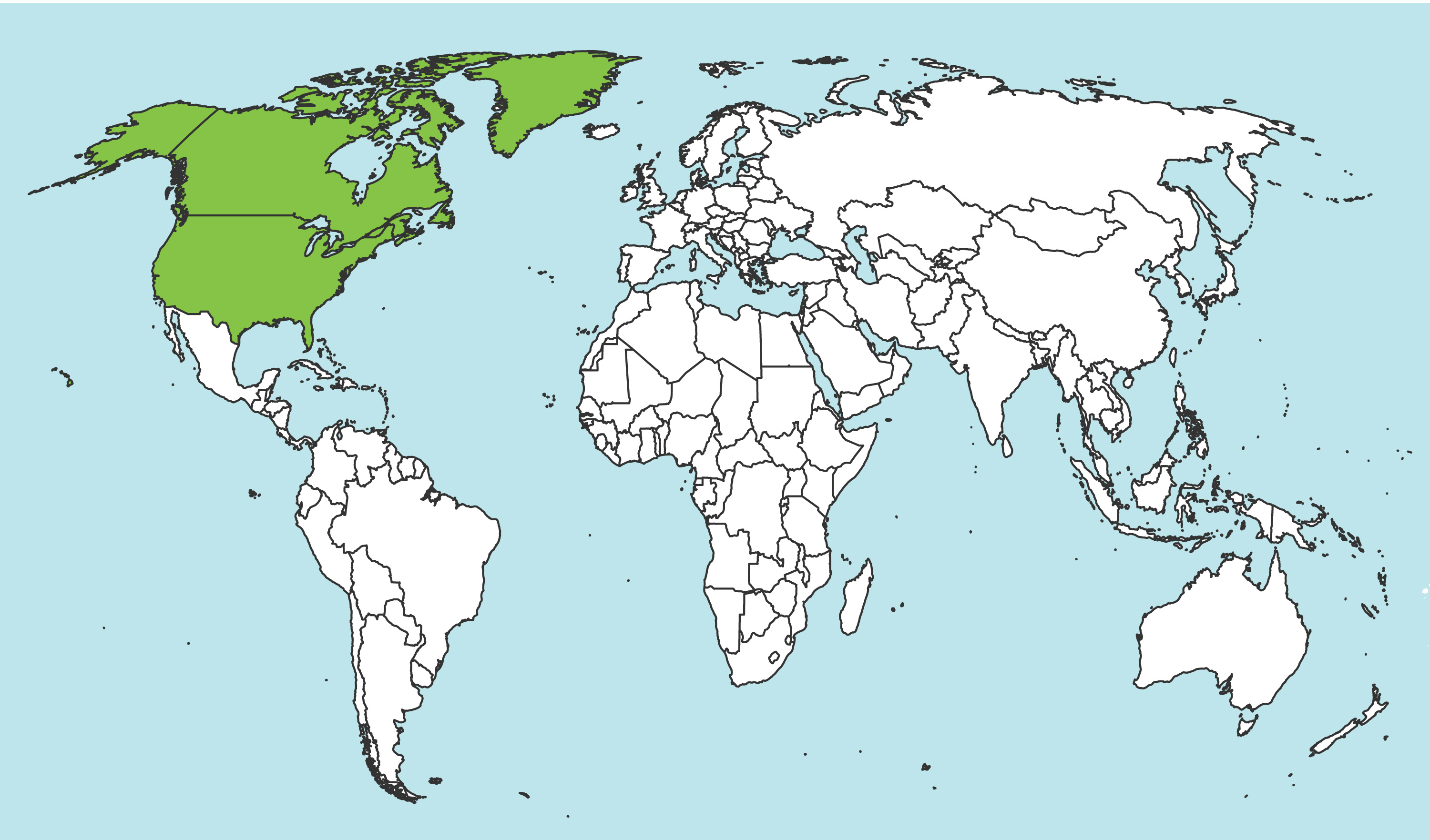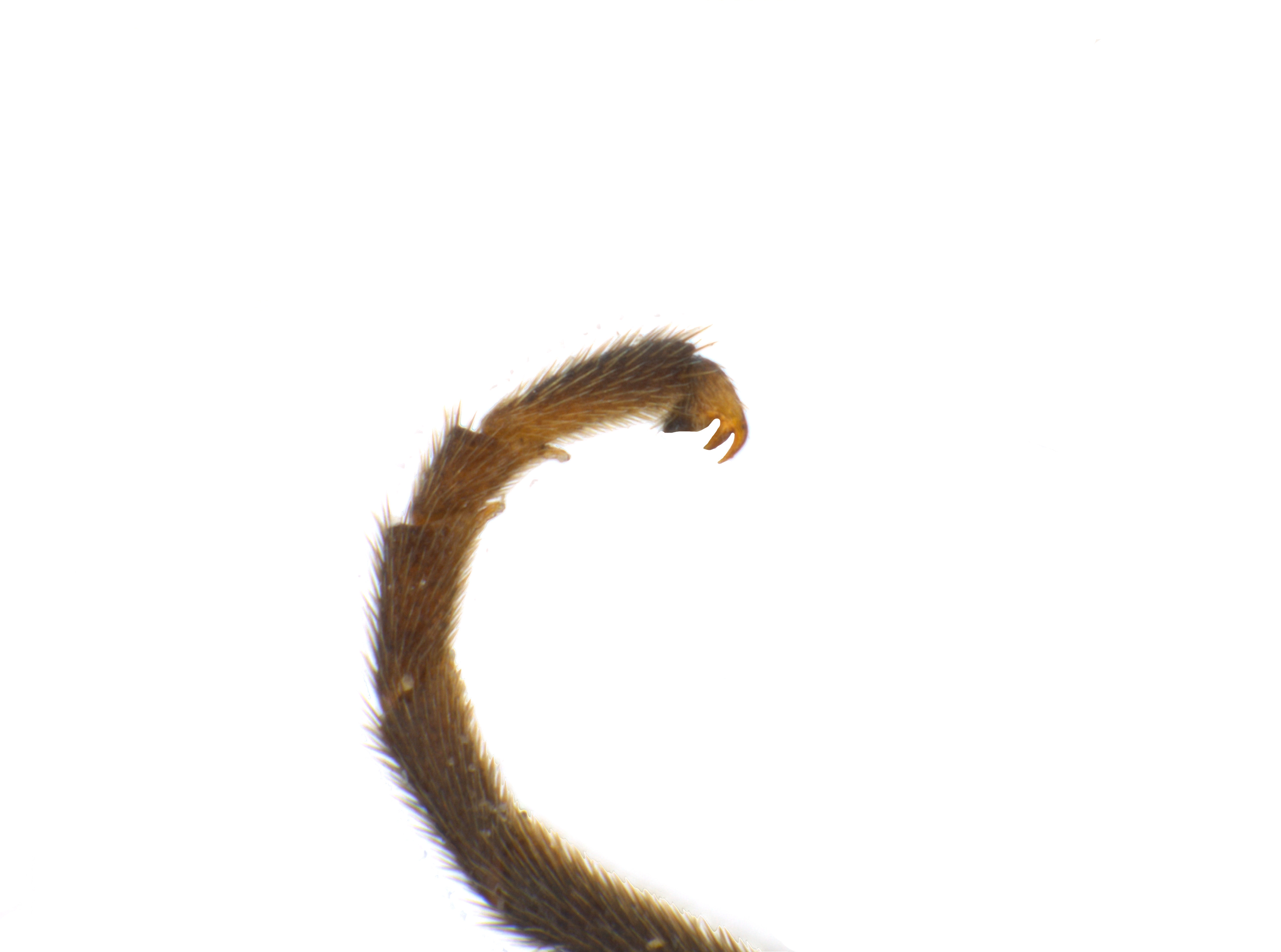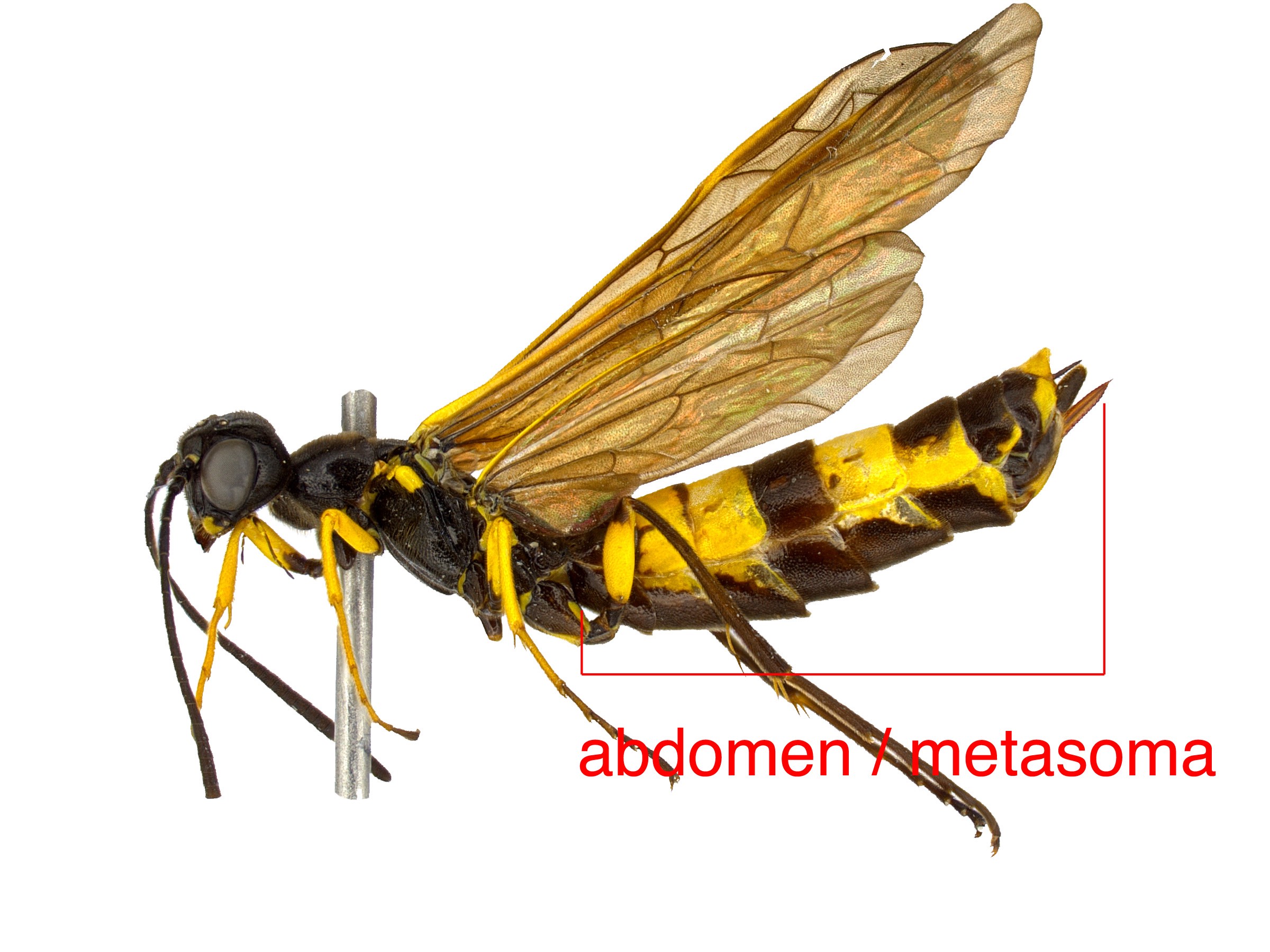Family: Tenthredinidae
Family common name: common sawflies
Subfamily: Allantinae
Tribe: Empriini
Genus: Monsoma MacGillivray, 1908
Subgenera: none
The Tenthredinidae are the most species-rich family and are found throughout the world, in all continents but Antarctica. They are known as the “common sawflies.” They can generally be recognized by a cylindrical body and long, segmented antennaeantenna:
the sensory organ emerging from the front of the head, usually between the compound eyes and above the clypeus; includes the flagellum, scape and pedicel
 . Otherwise, they come in a variety of colors, sizes, and forms (Goulet 1992Goulet 1992:
. Otherwise, they come in a variety of colors, sizes, and forms (Goulet 1992Goulet 1992:
Goulet H. 1992. The genera and subgenera of the sawflies of Canada and Alaska: Hymenoptera. Symphyta. The insects and arachnids of Canada. Part 20. Agriculture Canada Publication.).
Sawflies in the Allantinae subfamily are mostly black and shining, sometimes with other colors. They have agricultural importance as some species are pests on cultivated and ornamental plants (Smith 1979aSmith 1979a:
Smith DR. 1979a. Nearctic sawflies. IV. Allantinae: Adults and larvae (Hymenoptera: Tenthredinidae). Technical Bulletin, U.S. Department of Agriculture 1595: 1-172.). They can be distinguished from other subfamilies by wing venationvenation:
the network of veins on a wing
(Smith 2003aSmith 2003a:
Smith DR. 2003a. A Synopsis of the sawflies (Hymenoptera: Symphyta) of America south of the United States: Tenthredinidae (Allantinae). Journal of Hymenoptera Research 12 (1): 148-192.).
Monsoma are medium-sized, about 6–8 mm in length. The two North American species are distinct, one mostly orange/yellow, the other mainly black (Smith 1979aSmith 1979a:
Smith DR. 1979a. Nearctic sawflies. IV. Allantinae: Adults and larvae (Hymenoptera: Tenthredinidae). Technical Bulletin, U.S. Department of Agriculture 1595: 1-172., Smith and Goulet 2000Smith and Goulet 2000:
Smith DR and Goulet H. 2000. Monosoma pulverata (Hymenoptera: Tenthredinidae), an alder-feeding sawfly new to North America. Entomological News 111: 238-242., Kruse et al. 2010Kruse et al. 2010:
Kruse JJ, Smith DR, and Schiff NM. 2010. Monsoma pulveratum (Retzius) (Hymenoptera: Tenthredinidae: Allantinae), a Palaearctic [sic] sawfly defoliator of alder in Alaska and new to the United States. Proceedings of the Entomological Society of Washington 112 (2): 332-335.).
There are three described extantextant:
in existence; opposite of extinct
species worldwide. Two occur in North America (Taeger et al. 2010Taeger et al. 2010:
Taeger A, Blank SM, and Liston AD. 2010. World Catalog of Symphyta (Hymenoptera). Zootaxa 2580: 1-1064.).
A NearcticNearctic:
describing the region of the Northern Hemisphere that includes North America south through northern Mexico
 key to species is included in Smith 1979aSmith 1979a:
key to species is included in Smith 1979aSmith 1979a:
Smith DR. 1979a. Nearctic sawflies. IV. Allantinae: Adults and larvae (Hymenoptera: Tenthredinidae). Technical Bulletin, U.S. Department of Agriculture 1595: 1-172..
Subfamily characters
 vein M and 1m-cu parallel (Smith 1979aSmith 1979a:
vein M and 1m-cu parallel (Smith 1979aSmith 1979a: vein 2A+3A complete, connected to 1A by crossveincrossvein:
vein 2A+3A complete, connected to 1A by crossveincrossvein:Genus characters
 (Smith 1979aSmith 1979a:
(Smith 1979aSmith 1979a: shallowly notched (Smith 1979aSmith 1979a:
shallowly notched (Smith 1979aSmith 1979a: vein 2r present (Smith 1979aSmith 1979a:
vein 2r present (Smith 1979aSmith 1979a: vein M intersecting Sc+R at the intersection of Sc+R and Rs+M (Smith 1979aSmith 1979a:
vein M intersecting Sc+R at the intersection of Sc+R and Rs+M (Smith 1979aSmith 1979a: without basalbasal:
without basalbasal:Monsoma can be confused with similar species in the subfamily Allantinae or tribe Empriini. It can be distinguished from most other genera by the complete genal ridge and the tarsal clawtarsal claw:
sharpened appendage emerging from the apex of the tarsus
 basalbasal:
basalbasal:
towards the base; closest to the body
lobe. It is especially similar to Empria, which can be recognized by paired white spots on the abdomenabdomen:
the third and last segment of an insect's body; in sawflies this is usually made up of 11 segments (segments 9 and 10 often fused) (Smith 1979aSmith 1979a:
(Smith 1979aSmith 1979a:
Smith DR. 1979a. Nearctic sawflies. IV. Allantinae: Adults and larvae (Hymenoptera: Tenthredinidae). Technical Bulletin, U.S. Department of Agriculture 1595: 1-172.).
none
Monsoma pulveratum is native to the Eastern Hemisphere, but was discovered in North America in Newfoundland in 1991 (Smith and Goulet 2000Smith and Goulet 2000:
Smith DR and Goulet H. 2000. Monosoma pulverata (Hymenoptera: Tenthredinidae), an alder-feeding sawfly new to North America. Entomological News 111: 238-242.). It became established in Alaska by 2007, where it caused significant defoliation of alder stands in the south-central area of the state (Kruse et al. 2010Kruse et al. 2010:
Kruse JJ, Smith DR, and Schiff NM. 2010. Monsoma pulveratum (Retzius) (Hymenoptera: Tenthredinidae: Allantinae), a Palaearctic [sic] sawfly defoliator of alder in Alaska and new to the United States. Proceedings of the Entomological Society of Washington 112 (2): 332-335.). In 2012, the species was detected in several sites in Idaho, Washington, and Oregon, but has not caused the severe defoliation observed in Alaska (Looney et al. 2012Looney et al. 2012:
Looney C, Sheehan K, Bai B, Flowers R, Kohler G, LaGasa E, McKorney AE, and Smith DR. 2012. The distribution of a potential new forest pest, Monsoma pulveratum (Hymenoptera: Tenthredinidae), in the Pacific Northwest states. Northwest Science 86 (4): 342-345.).
In North America, Monsoma feeds on Alnus (alder). One collection of M. inferentium in British Columbia was made on Salix (willow) (Smith 1979aSmith 1979a:
Smith DR. 1979a. Nearctic sawflies. IV. Allantinae: Adults and larvae (Hymenoptera: Tenthredinidae). Technical Bulletin, U.S. Department of Agriculture 1595: 1-172.).
The young larvaelarva:
the immature stage of holometabolous insects
 feed singly on foliage. Adults emerge in the spring. Described species of Monsoma are univoltineunivoltine:
feed singly on foliage. Adults emerge in the spring. Described species of Monsoma are univoltineunivoltine:
describing an insect with a life cycle of one generation per year
(Smith 1979aSmith 1979a:
Smith DR. 1979a. Nearctic sawflies. IV. Allantinae: Adults and larvae (Hymenoptera: Tenthredinidae). Technical Bulletin, U.S. Department of Agriculture 1595: 1-172., Kruse et al. 2010Kruse et al. 2010:
Kruse JJ, Smith DR, and Schiff NM. 2010. Monsoma pulveratum (Retzius) (Hymenoptera: Tenthredinidae: Allantinae), a Palaearctic [sic] sawfly defoliator of alder in Alaska and new to the United States. Proceedings of the Entomological Society of Washington 112 (2): 332-335.).
Monsoma pulveratum is native to the Eastern Hemisphere, but was discovered in North America in Newfoundland in 1991 (Smith and Goulet 2000Smith and Goulet 2000:
Smith DR and Goulet H. 2000. Monosoma pulverata (Hymenoptera: Tenthredinidae), an alder-feeding sawfly new to North America. Entomological News 111: 238-242.). The larvaelarva:
the immature stage of holometabolous insects
 of M. pulveratum are bright green with green and white stripes and white spots surrounding the spiracles (Kruse et al. 2010Kruse et al. 2010:
of M. pulveratum are bright green with green and white stripes and white spots surrounding the spiracles (Kruse et al. 2010Kruse et al. 2010:
Kruse JJ, Smith DR, and Schiff NM. 2010. Monsoma pulveratum (Retzius) (Hymenoptera: Tenthredinidae: Allantinae), a Palaearctic [sic] sawfly defoliator of alder in Alaska and new to the United States. Proceedings of the Entomological Society of Washington 112 (2): 332-335.). Feeding behavior is characterized by complete defoliation when populations are high; at lower densities feeding damage appears as a series of small holes in leaves (Looney et al. 2012Looney et al. 2012:
Looney C, Sheehan K, Bai B, Flowers R, Kohler G, LaGasa E, McKorney AE, and Smith DR. 2012. The distribution of a potential new forest pest, Monsoma pulveratum (Hymenoptera: Tenthredinidae), in the Pacific Northwest states. Northwest Science 86 (4): 342-345.). Males have not been collected in North America, suggesting that this species may reproduce parthenogeneticallyparthenogenesis:
a type of sexual reproduction where embryos are produced from unfertilized eggs
(Smith and Goulet 2000Smith and Goulet 2000:
Smith DR and Goulet H. 2000. Monosoma pulverata (Hymenoptera: Tenthredinidae), an alder-feeding sawfly new to North America. Entomological News 111: 238-242.).
World: This genus is known from North America, Europe, northern Africa, western Asia, western China (Smith 1979aSmith 1979a:
Smith DR. 1979a. Nearctic sawflies. IV. Allantinae: Adults and larvae (Hymenoptera: Tenthredinidae). Technical Bulletin, U.S. Department of Agriculture 1595: 1-172., Taeger et al. 2010Taeger et al. 2010:
Taeger A, Blank SM, and Liston AD. 2010. World Catalog of Symphyta (Hymenoptera). Zootaxa 2580: 1-1064.).
North America: Monsoma pulveratum is recorded in Newfoundland, Alaska, Washington, Idaho, Oregon, and Montana (Kruse et al. 2010Kruse et al. 2010:
Kruse JJ, Smith DR, and Schiff NM. 2010. Monsoma pulveratum (Retzius) (Hymenoptera: Tenthredinidae: Allantinae), a Palaearctic [sic] sawfly defoliator of alder in Alaska and new to the United States. Proceedings of the Entomological Society of Washington 112 (2): 332-335., Looney et al. 2012Looney et al. 2012:
Looney C, Sheehan K, Bai B, Flowers R, Kohler G, LaGasa E, McKorney AE, and Smith DR. 2012. The distribution of a potential new forest pest, Monsoma pulveratum (Hymenoptera: Tenthredinidae), in the Pacific Northwest states. Northwest Science 86 (4): 342-345.). Monsoma inferentium is recorded throughout the northeastern United States and eastern Canada, with some collections farther west in Alberta and British Columbia (Smith 1979aSmith 1979a:
Smith DR. 1979a. Nearctic sawflies. IV. Allantinae: Adults and larvae (Hymenoptera: Tenthredinidae). Technical Bulletin, U.S. Department of Agriculture 1595: 1-172.).
Map data from: GBIF.org (29 October 2019) GBIF Occurrence Download Monsoma
Details about data used for maps can be found here.